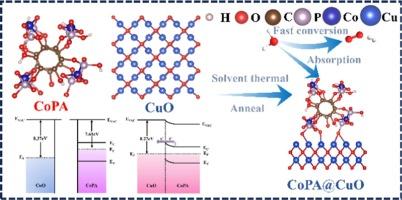非晶鞘层电催化剂双功能水分解的相位工程多尺度协同调制
IF 6.9
2区 材料科学
Q2 CHEMISTRY, PHYSICAL
引用次数: 0
摘要
界面工程在水电解催化剂方面具有巨大的潜力,但界面电子构型的精确操纵和结构完整性的保持仍然是一个巨大的挑战。在此,我们提出了一种创新的合成策略,通过简单和温和的工艺制备具有非晶/晶体核壳结构的纳米棒阵列材料(CoPA-0.5@CuO-300)。所得材料表现出优异的电催化性能,并显著加快了反应动力学。通过严格的实验表征和理论计算,我们阐明了三种协同机制:(1)非均匀界面的电子重配置有效地降低了反应能垒;(2)纳米棒阵列结构显著提高了电化学活性表面积,从而提供了更多的催化位点;(3)无定形外层,由于其无序结构,有利于吸附/解吸。利用这种协同效应,CoPA-0.5@CuO-300在1 M KOH条件下表现出出色的电催化性能,在电流密度为10 mA cm−2时,析氧反应(OER)和析氢反应(HER)过电位分别仅为159 mV和119 mV。在连续运行60 h后,催化剂的活性仍保持在98% %以上。这项工作提出了一种创新的结构设计方法,为开发高效耐用的非均相界面电催化剂提供了新的途径。本文章由计算机程序翻译,如有差异,请以英文原文为准。

Phase-engineered multiscale synergistic modulation in amorphous-sheathed crystalline electrocatalysts for bifunctional water splitting
Interfacial engineering holds great potential for water electrolysis catalysts, but the precise manipulation of interfacial electronic configurations and the maintenance of structural integrity remain a formidable challenge. Herein, we propose an innovative synthetic strategy to prepare nanorod array materials with an amorphous/crystalline core–shell structure (CoPA-0.5@CuO-300) through a simple and mild process. The resulting materials exhibited excellent electrocatalytic properties and significantly accelerated the kinetics of the reaction. Through rigorous experimental characterization and theoretical calculations, we elucidated three synergistic mechanisms: (1) the electronic reconfiguration of the non-homogeneous interfaces effectively reduces the reaction energy barriers; (2) The nanorod array structure significantly enhances the electrochemically active surface area, thereby providing a greater number of catalytic sites; and (3) the amorphous outer layer, due to its disordered structure, facilitates the adsorption/ desorption. By leveraging this synergistic effect, CoPA-0.5@CuO-300 demonstrated outstanding electrocatalytic performance under 1 M KOH conditions, achieving Oxygen evolution reaction (OER) and Hydrogen evolution reaction (HER) overpotentials of only 159 mV and 119 mV, respectively, at a current density of 10 mA cm−2. Moreover, the catalyst retained over 98 % of its initial activity after 60 h of continuous operation. This work presents an innovative structural design approach that offers a novel pathway for developing highly efficient and durable non-homogeneous interfacial electrocatalysts.
求助全文
通过发布文献求助,成功后即可免费获取论文全文。
去求助
来源期刊

Applied Surface Science
工程技术-材料科学:膜
CiteScore
12.50
自引率
7.50%
发文量
3393
审稿时长
67 days
期刊介绍:
Applied Surface Science covers topics contributing to a better understanding of surfaces, interfaces, nanostructures and their applications. The journal is concerned with scientific research on the atomic and molecular level of material properties determined with specific surface analytical techniques and/or computational methods, as well as the processing of such structures.
 求助内容:
求助内容: 应助结果提醒方式:
应助结果提醒方式:


